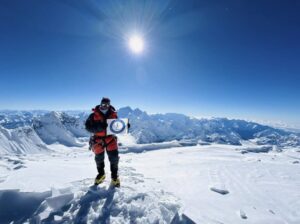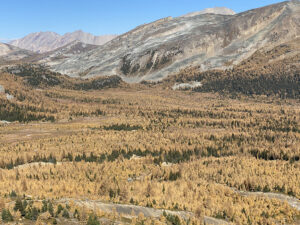“I pursue happiness, and the mountain answers my search.”
With this quote from the late French climber Chantal Mauduit, we showcase a piece on the beauty of mountains, themed by colors, sensations, and interesting forms.
Mountains may be a kind of release, an escape from reality.
Mountains in orange
Gasherbrum IV, Karakoram
Just shy of the magical 8,000m mark, 7,925m Gasherbrum IV is one of the most beautiful of all peaks. In the Balti language, “rgasha” means beautiful, and “brum” means mountain. For some aesthetically driven climbers, it is the ultimate mountain.
Its west face, aka the Shining Wall, was first ascended in 1985 by Polish climber Wojciech Kurtyka and Austrian Peter Schauer. They did not reach the summit, but the West Face will be linked to their names forever. Kurtyka described the pure alpine-style climb: “The sound of beautiful and passionate women singing, something between Barbra Streisand and Santana…came from the rubbing of the rope sliding over the rough snow surface, punctuated by our steps.”

Gasherbrum IV. Photo: Tariq Hameed Sulemani
Mianzimu, Meili Xue Shan range, Yunnan, China
Mianzimu (6,054m) is the fourth highest peak in the Meili Xuye Shan range. It sits near the highest peak, 6,740m Kawagarbo, the reincarnation of a dead prince. According to local legend, Mianzimu is Kawagarbo’s spouse. Mianzimu, like Kawagarbo, remains officially unclimbed.

Mianzimu. Photo: Sebastian Alvaro
Mont Blanc, Alps
Mont Blanc’s height was remeasured in September 2021 at 4,807.81m.
According to myth, there was an enchanted kingdom at its summit, where the White Goddess, the queen of the fairies lived. She dwelled in green meadows and oversaw the destiny of the inhabitants of the valley. According to beliefs of the time, these divine entities should be respected and venerated, since the mountains emitted a supernatural influence that guided men without their knowledge.
In 1762, scientist, mountaineer, and philosopher Horace-Benedict de Saussure offered 20 silver coins, also called thalers, to anyone who could find a route to the summit of Mont Blanc. Various unsuccessful attempts were made. Finally, on August 8, 1786, two amateur mountaineers, Jacques Balmat and Michel Gabriel Paccard, reached the top for the first time.

Mont Blanc. Photo: Mathis Dumas
Machhapuchhre, Himalaya
New Zealander Bill Denz possibly climbed this beautiful but forbidden 6,993m peak in the late 1970s illegally. The fishtail double summit of Macchapuchhre has inspired artists and photographers from all over the world.

Macchapuchhre. Photo: Nepal Trek
K2 (Chogori), Karakorum
About this beautiful, savage 8,611m mountain, Italian photographer, anthropologist, and mountaineer Fosco Maraini once lyrically wrote, “Just the bare bones of a name, all rock and ice, and storm and abyss. It makes no attempt to sound human. It is atoms and stars. It has the nakedness of the world before the first man, or of the cindered planet after the last.”

K2. Photo: Sebastian Alvaro
Chogolisa
Chogolisa is one of a group of several summits in that part of the Karakoram. The Chogolisa group’s main summit is the southwest one (7,665m) at the Vigne and Kaberi Glaciers. The second highest, at 7,654m, lies on the northeast side, at the Blatoro and Kaberi Glaciers.
One of the best alpinists of all time, Austria’s Hermann Buhl lost his life on Chogolisa when he fell through a cornice. He was among the first mountaineers to introduce alpine-style climbing to the Himalaya.
“Me, not belonging in the mountains? Why, I couldn’t go on living without them!,” Buhl wrote in his book Nanga Parbat Pilgrimage. “My thoughts, my dreams, my whole life were nothing but the mountains.”

Chogolisa, seen from K2 Base Camp. Photo: Luis Miguel Lopez Soriano
Mountains in blue
Gasherbrum VI
This 7,004m peak in the Karakoram remains officially unclimbed. There have probably been only five attempts to climb it. Bristling with serac avalanches and large overhanging cornices, its steep slopes guard its secret.
In 1985, a young Italian woman, Maria Luisa Ercolani, claimed to have summited Gasherbrum VI from the Abruzzi Glacier. However, she did not present any details of her climb. In Mountain 106, the American Alpine Club wrote: “The likely route of ascent involves considerable objective dangers and steep ice, and seems to have been achieved with no support whatsoever. Because of her age and sex, her activities were treated with incredulity by climbers in the vicinity and even more so by the Pakistanis.”

Up close on Gasherbrum VI. Photo: Sebastian Alvaro
An unnamed beauty
Can there be a more impressive kingdom than an unnamed and probably unclimbed peak? Most climbers target well-known mountains. But there is another choice, for those who want to know the unknown. So stands this sharp, unnamed 5,000’er in the Karakoram, in front of Laila Peak.

The unnamed 5,000’er. Photo: Sebastian Alvaro
Gasherbrum II and III
The photo below could have been taken of Ered Luin — the Blue Mountains in Tolkien’s fictional universe. Gasherbrum II (8,035m) was first climbed on July 7, 1956 by Fritz Moravec, Josef Larch, and Hans Willenpart. They made its first ascent via the southwest ridge. Swiss climbers Romolo Nottaris and Tiziano Zund carried out the first alpine-style ascent on August 3, 1981.
Gasherbrum III (7,952m) stood unclimbed until August 11, 1975, when Wanda Rutkiewicz, Alison-Chadwick-Onyszkiewicz, Janusz Onyszkiewicz, and Krzystof Zdzitowiecki of Poland finally summited. As its prominence is only 355m, it isn’t always considered an independent mountain, but rather a subpeak of Gasherbrum II. Despite this, it is still a great challenge.

Gasherbrum II (on the right) and Gasherbrum III (on the left). Photo: Sebastian Alvaro
Jethi Bahurani
A jewel of the far western Himalaya, Jethi Bahurani (6,850m) has only one successful recorded ascent. On April 27, 1978, Kazuo Mitsui, Hideki Yoshida, and Nobuhito Morota managed to summit via the very steep east ridge. As they only had permission for another mountain, the leader of the Japanese team was banned from climbing in the Himalaya for five years.

Jethi Bahurani. Photo: Luke Smithwick
Towers
Naisa Brakk
The photos say everything about this stunning 5,200m Karakoram peak, the very epitome of a mountain tower. Its name means “arrowhead tower”. Usually, people call it — wrongly — Nayser Brakk, but the correct name is Naisa Brakk.
Located in Charakusa Valley in Pakistan, its northeast ridge, aka the British route, was first ascended in 1988 by Dave Hamilton and Andy Bunnage. The tower sometimes serves to acclimatize climbers for the higher neighboring peaks, but there is no easy way to its top.

Naisa Brakk. Photo: Rizwan Saddique
Uli Biaho tower
Located in the Karakoram, near Trango Towers and the Baltoro Glacier, this impressive 6,109m tower first fell to Americans John Roskelley, Ron Kauk, Bill Forrest, and Kim Schmitz on July 3, 1979. They progressed through difficult ice, mixed climbing, and a very precarious final section, past the summit ice mushroom.

Uli Biaho Tower. Photo: Sebastian Alvaro
Snowpatch Spire
Snowpatch (3,084m) is one of British Columbia, Canada’s famed Bugaboo Spires. It was one of the last one of its group to be climbed when it was summited by Raffi Bedayan and Jack Arnold in 1940.

Snowpatch Spire. Photo: Will Stanhope
Trango Tower
Also called Nameless Tower (6,239m), it is one of the most world’s difficult climbs. You have to fight against the cold, the freakish weather, and the lack of oxygen. Among its eight routes, none are easy.
Trango Tower was first ascended on June 8, 1976, by Britons Joe Brown, Mo Anthoine, Martin Boysen, and Malcolm Howells via the southwest face.
Wojciech Kurtyka and Erhard Loretan climbed it in July 1988, via a new route on the east face. Kurtyka compared “this technically extreme, big-wall ascent with two-man ascents on 8,000m peaks. The Trango climb, he added, was even more technical and physical.

David Lama on the summit of the Trango Tower. Photo: Corerich Productions
The weird and the wonderful
Eystrahorn
This 756m little-known mountain lies in east Iceland. Though low, it is one of the tallest peaks in the Krossasnesfjall range. It is one of the very few mountains that can not be climbed in Iceland because of the difficult terrain and the constant landslides.

Eystrahorn, aka Batman Mountain. Photo: Goodfon
Eytrahorn is also called the Batman Mountain because of its distinctive shape and brooding appearance. The picturesque area includes the big Vatnajokull Glacier and beaches of black sand.

Eystrahorn. Photo: Iceland Discovery
La Pedriza, or maybe Alpha
“There is hope and a kind of beauty in there somewhere, if you look for it,” said Swiss artist Hans Ruedi Giger, creator of the Alien in the film of that name.
On La Pedriza, in the Sierra of Madrid in Spain, there are some really strange granite formations. One of them, below, evokes Giger’s Alpha creature.

Left: Alpha by H.R. Giger Photo: H. R. Giger. Right: A granite formation on La Pedriza. Photo: Kris Annapurna
Devil’s Tower
In the northeast of Wyoming, Devil’s Tower rises 386m above the surrounding terrain. Its summit is 1,558m above sea level. It featured prominently as the mysterious shape that obsessed Richard Dreyfuss in Close Encounters of the Third Kind.

Lightning at Devil’s Tower. Photo: Matt Hill
According to the Kiowa and Lakhota Sioux Native American legends, some girls were out playing when giant bears tried to catch them. The frightened girls ascended to the top of a rock, dropped to their knees, and started to pray. Hearing their prayers, the Great Spirit raised the rock from the earth to the sky, so that the bears could not reach the girls. Then the bears started to climb the huge tower, leaving deep claw marks on its sides. As the tower was too steep, the bears could not climb very high. The girls ascended to heaven and became the Pleiades, a group of stars within the constellation Taurus.

Devil’s Tower. Photo: Cason JD
Prisojnik
Prisojnik is a 2,547m mountain in Slovenia’s Julian Alps. Its northern wall seems to show the face of a girl.
According to the legend, Heathen Maiden (in Slovene, Ajdovska deklica), a mythical creature and nymph, prophesied that a newborn would kill Goldenhorn, the chamois. When the other nymphs heard this, they considered the prophecy inadmissible and as punishment, they turned her into stone.

The northern wall of Prisojnik mountain. Photo: Dreamstime





